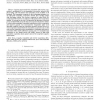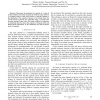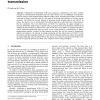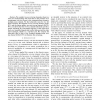CORR
2007
Springer
14 years 13 days ago
2007
Springer
Abstract—Capacity improvement from transmitter and receiver cooperation is investigated in a two-transmitter, two-receiver network with phase fading and full channel state inform...
CORR
2007
Springer
14 years 13 days ago
2007
Springer
—This paper characterizes the capacity of a class of modulo additive noise relay channels, in which the relay observes a corrupted version of the noise and has a separate channel...
CORR
2007
Springer
14 years 13 days ago
2007
Springer
— We establish the optimal diversity-multiplexing (DM) tradeoff of coherent time, frequency and time-frequency selective-fading MIMO channels and provide a code design criterion ...
CORR
2007
Springer
14 years 13 days ago
2007
Springer
: Collaborative beamforming (CB) and cooperative transmission (CT) have recently emerged as communication techniques that can make effective use of collaborative/cooperative nodes ...
CORR
2007
Springer
14 years 13 days ago
2007
Springer
CORR
2007
Springer
14 years 13 days ago
2007
Springer
— We examine the problem of determining which nodes are neighbors of a given one in a wireless network. We consider an unsupervised network operating on a frequencyflat Gaussian...
CORR
2007
Springer
14 years 13 days ago
2007
Springer
We propose two alternatives to Xu’s axiomatization of Chellas’s STIT. The first one simplifies its presentation, and also provides an alternative axiomatization of the delib...
CORR
2007
Springer
14 years 13 days ago
2007
Springer
—We consider two-way wire-tap channels, where two users are communicating with each other in the presence of an eavesdropper, who has access to the communications through a multi...
CORR
2007
Springer
14 years 13 days ago
2007
Springer
An important goal for digital libraries is to enable researchers to more easily explore related work. While citation data is often used as an indicator of relatedness, in this pap...
CORR
2007
Springer
14 years 13 days ago
2007
Springer
— This work considers the problem of transmitting multiple compressible sources over a network with minimum cost. The problem is complicated by the fact that the description of t...






